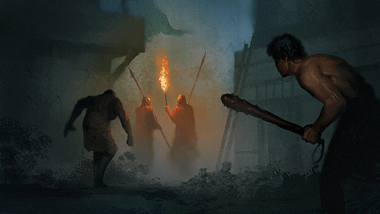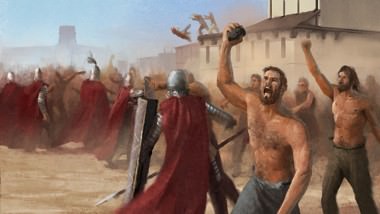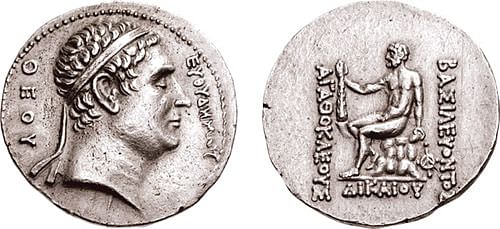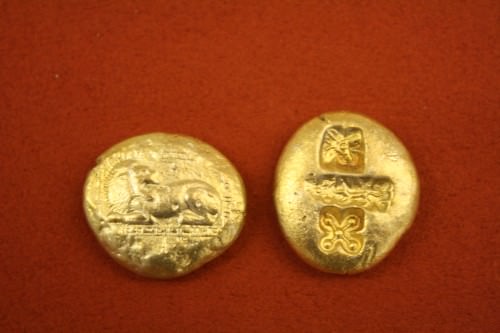Cohortes Urbanae › Coinage › Shamanism in Ancient Korea » Origins and History
Articles and Definitions › Contents
- Cohortes Urbanae › Origins
- Coinage › Origins
- Shamanism in Ancient Korea › Origins
Ancient civilizations › Historical places, and their characters
Cohortes Urbanae › Origins
Definition and Origins

The cohortes urbanae ( urban cohorts ) were a body of troops garrisoned at Rome, which was created by Augustus to provide additional security for the emperor and city in general. Expanding in the reigns of subsequent emperors the force was responsible for maintaining public order in the capital and other cities they were stationed at. Effectively acting as a police force it was also occasionally employed in battles and even involved itself in the succession of emperors.
CREATION
Near the end of his reign (27 BCE - 14 CE), Augustus created the first three urban cohorts, likely recruiting them from the existing Praetorian Guard ( cohortes praetoriae ) which was also stationed in Rome. The precise date of their foundation is not known, but the first reference in literature is from Suetonius who mentions that each member received 500 sesterces in Augustus' 13 CE will.
As there were nine cohorts of the Praetorian Guard, the urban cohorts were given the numbers X, XI, and XII, which were maintained even when the Guard was later expanded by another three cohorts. Besides providing an additional military force which the emperor could call on in cases of emergency or revolt, they would later be used, on occasion, in both civil and foreign wars by later emperors.
THE TERM OF SERVICE IN THE URBAN COHORTS WAS 20 YEARS & THEY RECEIVED 50% MORE PAY THAN ORDINARY LEGIONARIES.
COMMAND STRUCTURE & CAMP
The urban cohorts were commanded by the urban prefect ( praefectus urbi ). As this position held senatorial rank, the holder was above the Praetorian prefect and he was responsible for all criminal cases not just in Rome but all of Italy. Thus the commander of the urban cohorts had significant power, and when emperors were absent on campaign, they were, in effect, the most senior officer in the capital. Each cohort was commanded by a tribune and six centurions. As with the Praetorian Guard, members were largely recruited from Italy to ensure greater loyalty. The term of service was 20 years, and they received 50% more pay than ordinary legionaries but half the pay of the more prestigious Praetorian Guard, with whom they shared a camp, the castra praetoria, in the north-eastern suburbs of Rome. In 270 CE the urban cohorts were given their own camp in the city by Aurelian, the castra Urbana, located on the Campus Martius. It is likely, too, that small detachments were stationed in watchhouses across the city on a rotation basis.

Castra Praetoria
FUNCTION
The primary function of the cohortes urbanae, as with most other troops not involved directly in combat, was to maintain public order. There are no surviving records which detail exactly what the urban cohorts did, but one can imagine in a large city like Rome there were plenty of instances of minor crime and disturbances to deal with as well as crowd-control duties at such popular events as gladiator games at the Colosseum and chariot races at the Circus Maximus. There might also have been more serious events to deal with such as food riots and demonstrations. Their role as a body which kept public order is largely assumed from the absence of any other military function or guard duties related to the emperors rather than direct evidence from Roman writers. In addition, the fact that their commander was responsible for criminal cases in the city would suggest that the urban cohorts would have sought out and arrested criminals for trial.
The role of policing the capital was a new one, though, and the difficulties of what exactly that entailed is evident in the resignation of the prefect Valerius Messalla Corvinus, after only six days in office on the grounds that he was not clear how to fulfil his duties. The first permanent commander of the urban cohorts was Lucius Calpurnius Piso, appointed in 13 CE.

Street Riot
EVOLUTION
As with the Praetorian Guard, the urban cohorts found time to meddle in politics and they supported or defied certain emperors, starting with the turmoil which followed Caligula 's assassination in 41 CE. Claudius gained their support, and perhaps as a consequence, they were expanded with another cohort added to their ranks. During the reign of Nero (54-68 CE) they were expanded again and this time reorganised into seven 500-man cohorts bearing the numbers X to XVI. The tinkering continued with Vitellius reshuffling the force into four 1000-man cohorts in 69 CE and mixing in some veteran legionaries. With Rome now perhaps a little overpacked with troops, Vespasian and his successors Titus and Domitian decided to remove two cohorts and station one each at Carthage and Lugdunum (modern Lyon), both provincial capitals, and the latter a major mint.At certain times, probably to protect grain shipments, urban cohorts were deployed at Ostia and Puteoli too.
Yet another expansion, in fact the last change, came during the reign of Septimius Severus (193-211 CE) with four cohorts being maintained but each now consisting of 1,500 men. The demise of the urban cohorts came in the aftermath of the Battleof Milvian Bridge in 312 CE. They and the Praetorian Guard had supported Maxentius, and so the victor Constantine Idisbanded the Praetorians and greatly reduced the significance of the urban cohorts in Rome. The two cohorts in the provinces had likely already been disbanded a century or so earlier.
Coinage › Origins
Definition and Origins

Coins were introduced as a method of payment around the 6th or 5th century BCE. The invention of coins is still shrouded in mystery: According to Herdotous (I, 94), coins were first minted by the Lydians, while Aristotle claims that the first coins were minted by Demodike of Kyrme, the wife of King Midas of Phrygia. Numismatists consider that the first coins were minted on the Greek island of Aegina, either by the local rulers or by king Pheidon of Argos.
Aegina, Samos, and Miletus all minted coins for the Egyptians, through the Greek trading post of Naucratis in the Nile Delta.It is certain that when Lydia was conquered by the Persians in 546 BCE, coins were introduced to Persia. The Phoeniciansdid not mint any coins until the middle of the fifth century BCE, which quickly spread to the Carthaginians who minted coins in Sicily. The Romans only started minting coins from 326 BCE.
Coins were brought to India through the Achaemenid Empire, as well as the successor kingdoms of Alexander the Great.Especially the Indo-Greek kingdoms minted (often bilingual) coins in the 2nd century BCE. The most beautiful coins of the classical age are said to have been minted by Samudragupta (335-376 CE), who portrayed himself as both conqueror and musician.

Miletos Electrum Stater
The first coins were made of electrum, an alloy of silver and gold. It appears that many early Lydian coins were minted by merchants as tokens to be used in trade transactions. The Lydian state also minted coins, most of the coins mentioning king Alyattes of Lydia. Some Lydian coins have a so-called legend, a sort of dedication. One famous example found in Caria reads "I am the badge of Phanes" - it is still unclear who Phanes was.
In China, gold coins were first standardized during the Qin dynasty (221-207 BCE). After the fall of the Qin dynasty, the Hanemperors added two other legal tenders: silver coins and "deerskin notes", a predecessor of paper currency which was a Chinese invention.
Shamanism in Ancient Korea › Origins
Ancient Civilizations
Shamanism was widely practised in Korea from prehistoric times right up to the modern era. It is a belief system which originated in north-east Asian and Arctic cultures, and although the term shamanism has since acquired a wider meaning across many different cultures, in ancient Korea it kept its original form where self-appointed practitioners promised to contact and influence the spirit world in order to assist the living. Shamans were given their authority by those who believed in their worth. As such it is not a religion, and there was no hierarchical priesthood, no texts, and no dogma to adhere to. For much of Korea's recorded history, Buddhism was the official state religion, but shamanism continued to be important to the ordinary, largely peasant population. Its influence on ancient Korean culture is most tangible in surviving art, architecture, literature, and music.

Korean Bangsadaps
RITUALS & PRACTITIONERS
In shamanism, called in Korean misin or 'superstition,' it is thought that there is another world besides that of the living, and in this spirit world there are both good and bad entities who can influence human affairs. In addition, shamanism was mixed with elements of animism, where natural features such as trees, mountains, rocks, and rivers are believed to possess their own spirits, and with the idea of geomancy, where any placement of houses, temples, and graves, for example, is carefully considered to take into account and best benefit from the location of such spirit-dwellings and life forces. A shaman, at least for believers, has the ability not only to establish contact with these spirits but to actually enter their world. Alternatively, in a kutritual, a spirit or specific god may temporarily possess or cohabit the body of the shaman and be capable of holding a conversation. He or she does this in an altered state of consciousness or trance which is reached through prolonged chanting and dancing accompanied by drumming and bell ringing. Finally, shamans were also credited with healing powers and the ability to promote positive effects on the body such as fertility and longevity.
SHAMANS HAD NO AFFILIATION WITH ANY PARTICULAR BODY NOR ANY RELIGIOUS RESPONSIBILITY, BELIEVERS EMPLOYED THEM AT THEIR OWN RISK, AS IT WERE.
Female shamans were known as mudang while males were paksu or pansu, with evidence that there were many more of the former, largely because it was one of only four professions that women were allowed to pursue. To become a shaman did not require any particular ceremony, learning, or initiation. Self-appointed, shamans often claimed a spiritual experience, typically during an illness, and so practised then onwards. Daughters of mudang commonly followed their mother's footsteps and became shamans too. These shamans had no particular place or temple in which to practice their abilities but performed wherever they were needed. Some shaman shrines did exist, such as those in mountain areas dedicated to Sansin, the Mountain God.
Shamans had no affiliation with any particular body nor any religious responsibility, believers employed them at their own risk, as it were. However, many people did believe in their ability to act as a medium between this world and the spirit realm. One group of spirits, in particular, the chosang or ancestral spirits, could be troublesome and were blamed for all manner of negative occurrences. A shaman was then employed to contact these spirits and find out the reason for their restlessness so that they might be mollified into departing from the affairs of the living.

Korean Mudang or Female Shaman
Mudang and paksu must have had many successes for shamans are thought to have been amongst the community leaders in the early societies of ancient Korea, even perhaps to have been the single ruler. One of the terms for early Silla kings was chachaung or shaman. The possibility is further suggested by the designs of gold crowns from the 5th-6th century CE royal tombs of the Silla kingdom. These crowns have tree-like appendages, a motif commonly found in the art of shamanism, and similar to those from Siberian tribes. The contemporary Baekje ( Paekche ) kingdom also produced a type of branch-like adornment for their royal crowns. Korean mythology describes leaders such as the founder of the Korean race Dangun as having shamanist qualities or heritage, and he is sometimes portrayed in art as Sansin (or vice-versa).
COEXISTENCE WITH OTHER RELIGIONS
From the Goryeo dynasty (918 - 1392 CE) onwards, as Confucian principles and Buddhism grew in importance, shamanism diminished in terms of its influence on government and state affairs. Some queens did employ their own personal shamans and sometimes they were called on by governments in times of crisis like severe droughts or floods, but during the Joseon dynasty from the 14th century CE there were specific measures to exclude shamans from the royal court.
All shamans had to be registered, and a government official was appointed to supervise their activities. This was due to the adoption of Neo- Confucianism and a general aristocratic disapproval of shamanism with its unseemly dancing and mixes of the sexes at rituals. However, it continued to hold a strong influence over the ordinary, largely rural population, who had no qualms about accepting the validity of this and other religions from traditional ancestor worship to state-endorsed Buddhism.Indeed, folk religion had long been an eclectic mix of shamanism, animism, simplified Buddhism, Taoism and Confucianism, and this is evidenced in the equally eclectic imagery seen in Korean folk art.
SHAMAN ART
Shaman paintings, usually an artist's or even shaman's attempt to capture the experience of a kut ritual, were created on silk, paper, and cotton. They are rather primitive without any attempt to present perspective but do possess a boldness and vitality.The subject matter can be also rather limited with a small cast of gods appearing with great frequency. The Mountain God Sansin is a favourite, and he is depicted as an old man with a long white beard, usually sitting under a pine tree and accompanied by his tiger messenger. Other popular gods include Yongwang, the Dragon King, and Haenim and Talnim, the sun and moon spirits respectively. Some gods are of Buddhist origin such as the Sambul chesok or Three Buddhas who appear on so many paper fans used by shamans in rituals.

Gold Crown of Silla
During rituals, these paintings were hung on walls or, if outside, placed on screens or pegged to suspended lines. White, blue, and yellow are the most common colours used in such paintings. Paintings frequently incorporate elements of Buddhism, indeed Buddhist monks were tasked with painting them, and so the scenes can contain both figures of Buddha and Shaman figures like Chilsong, the Seven Star spirit, and constellations important to shamanism such as the Great Bear as well as the north pole star and nine planets. In these mixed-style paintings red is used much more than in purely shamanistic works.Another form of painting was pujok, the temporary posters pinned to doorways, walls, and chests to ward off evil spirits. These most often depicted rudimentary drawings of tigers, dogs, cockerels, and lions.
Other art forms include the shaman-influenced royal crowns of the Three Kingdoms period already mentioned and bronze star-shaped rattles or bells, also from ancient tombs, which were probably used in rituals and date to the 3rd century BCE.Shamanism influenced Buddhist architecture, notably the stone pagodas set in front of temples which sometimes had seven circular rings to represent the seven stars of the Great Bear constellation. Buddhist sculpture, too, sometimes took inspiration from shaman iconography. For example during the 11th century CE very large figures of Buddha as Maitreya (the coming Buddha) were carved out of natural boulders and many wear unique tall hats which some scholars suggest may represent a link with shamanism. Examples can be found at Paju and at the Kwanchok temple in Nonsan.
This article was made possible with generous support from the British Korean Society.
LICENSE
Article based on information obtained from these sources:with permission from the Website Ancient History Encyclopedia
Content is available under License Creative Commons: Attribution-NonCommercial-ShareAlike 3.0 Unported. CC-BY-NC-SA License